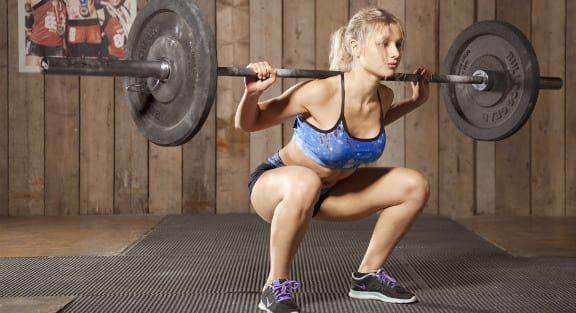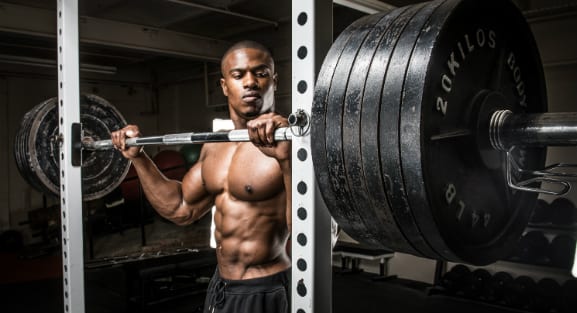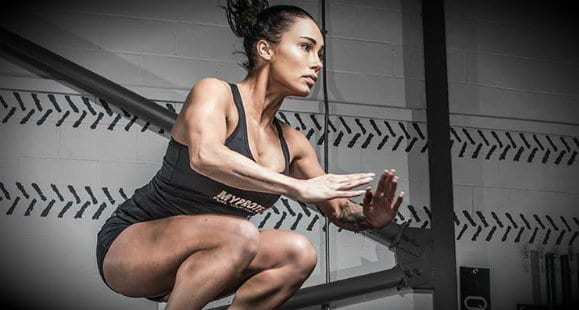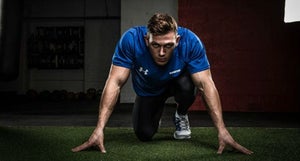
Written by George Platt
As well as the conventional back squat or front squat, there are actually a number of other squat techniques which are useful for increasing your usual squatting strength, general lower body hypertrophy and increasing your mobility. This article will detail four variations of the squat which the majority of us have never tried but should probably make use of!Overhead Squat
The overhead squat is a very technical movement which requires a lot of balance, core strength and mobility; especially in the shoulders. This exercise usually requires you to travel the bar above your head by using a snatch or a clean and jerking movement; however, you can un-rack from a squat rack and re-position your hands to press the bar above your head if that’s easier for you.The lift involves you keeping the weight above your head, descending into a squat and coming back up with your arms remaining above your head; it’s a very technical movement that will help improve your core strength, balance and mobility.
Technique
1: Grip the bar with a wide grip2: Bring the bar up to rest on your quadriceps3: Snatch the weight up above your head by pulling the bar towards you, thrusting forwards and firing the bar up above your head 4: Position the bar in line with the back of your head/neck5: Point elbows down (flare armpits outwards)6: Descend your backside towards the floor and let your knees travel forwards above your feet7: Explode upwards to the top of the movement and repeatThings to note: This exercise can be very hard to perform as it requires mobility in the shoulders, hips and ankles. Be sure to fix any mobility issues before attempting the overhead squat.Anderson Squat
The Anderson Squat was named after Paul Anderson who was an olympic weightlifter and strongman. Anderson squats begin the movement “in the hole” at the bottom of a conventional squat, with a pause at the bottom of each rep.You’ll use the safety racks on a squat rack to set the bar at a comfortable height for you to begin and end each repetition from the bottom of the movement. Simply, this exercise stops you from bouncing at the bottom of a squat and shifts more focus onto pressing with the quadriceps out of the hole.

Technique:
1: Set the safety bars to a height where you can place the bar on it and get into a squat position beneath, with the bar resting on your traps (as you would hold the bar using a conventional squat)2: Make sure your feet are in a comfortable position and your form is right to start the movement3: Engage your quadriceps and push upwards until you reach the top of the squat3: Descend back down and let the bar touch the safety racks 4: Take a pause for 2 seconds and begin the movement again5: Repeat for desired amount of reps/sets.This is a fantastic exercise for overall leg development and increasing the strength of your squat. By stopping at the bottom of the movement and using this as a starting point you are forced to become more comfortable of being down in the hole of a squat, making your exit from the hole much stronger.Hack Squat
There are two methods of Hack Squats; one of which is using the hack-squat machine, which is a plate loaded piece of equipment that slides on rails similarly to the smith machine, with a platform for your feet at the bottom (you will travel at an angle of around 45 degrees using this machine).
Using the machine is very self explanatory and most gyms nowadays have a hack squat machine for you to use. With this being the case we're going to talk through the barbell hack squat variation, which is a much less common exercise that requires more stability and core strength.Using the barbell hack squat method is similar to a deadlift, however the barbell you’ll be lifting will be behind your body as opposed to in front of your legs.
Technique:
1: Place a barbell with your desired amount of weight on the ground2: Squat down and take hold of the bar, with the bar being beneath your backside and close to your calves; face your palms backwards3: Keeping your heels firmly on the floor, your chest up, spine, neck and head neutral4: Push up while exhaling and let the bar travel from beneath you to behind your backside 5: Once you’re stood up straight, descend back in the same plane of motion until the barbell reaches the floor and then continue the next repetitionThis exercise is very similar to the deadlift, however because the weight is positioned behind your body as opposed to in front, the emphasis on the quadriceps is greater, as your back will take less of the load. Making the hack squat very good for quadriceps development. Note: Be sure to exhale on all concentric contractions and inhale on all eccentric movements.Zercher Squat
‘Zercher’ refers to the position you hold the bar when performing an exercise; which is in the crook of the elbows. Unfortunately, this position can be uncomfortable due to the soft skin in the crooks of your elbows, so this is best performed in long sleeved clothing or even by wearing knee sleeves on your elbows to protect them from the bar you’re holding.
The range of motion of the movement is exactly the same as a generic squat, however the position you hold the weight in means that you must keep your back straight, create a small arch in the power back and pin your chest up (retract your scapular); making this exercise very good for increasing core strength and improving posture while placing a lot of emphasis on the quads and glutes, similarly to the front squat. However, if you do not perform this exercise with strong form, it will cause you to round your back and perform ineffectively.

Take Home Message:
Hopefully you’ve read this and learnt that there are a number of different squat variations you can try out in your own training plan. Make sure your mobility is suitable for the lifts you attempt in order to avoid injury and most of all enjoy the variety of these exercises.Whey ProteinLean muscle
CreatineStrength, Power
MaltodextrinEnergy
BCAA'sMuscle recovery
Our articles should be used for informational and educational purposes only and are not intended to be taken as medical advice. If you're concerned, consult a health professional before taking dietary supplements or introducing any major changes to your diet.








